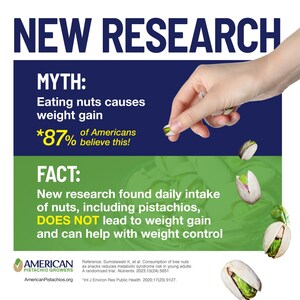Landmark Research Uncovers Health Benefits of Pistachios for Women with Gestational Diabetes
CHICAGO, Oct. 24, 2017 /PRNewswire/ -- Results of a new study among pregnant women with impaired glucose intolerance during gestation (GIGT) or gestational diabetes mellitus (GDM) - commonly known as gestational diabetes - show that eating pistachios may help manage blood sugar levels. The study is the first to evaluate the glucose response after consumption of pistachios in pregnant women with GDM or GIGT. The data were presented yesterday during the Academy of Nutrition and Dietetics' 2017 Food & Nutrition Conference & Expo™ in Chicago, Illinois.
Diabetes is a chronic illness that affects more than 422 million people around the world.1 Gestational diabetes mellitus (GDM) is a type of diabetes that develops in a pregnant woman who did not previously have diabetes.2 Like other types of diabetes, it affects how the body uses blood sugar.3,4 Impaired glucose tolerance during gestation (GIGT) occurs when, during pregnancy, the body is unable to regulate blood glucose levels normally because of hormonal changes. The blood glucose levels raise beyond normal levels after a glucose challenge, but not high enough to warrant a diabetes diagnosis. While resolved after the baby is born, women with either GDM or GIGT have a greater risk of developing diabetes.
According to the latest diagnostic criteria established by the International Association of Diabetes and Pregnancy Study Groups (IADPSG) in 2010, GDM prevalence was estimated at 9.8 - 25.5% worldwide.
"Our study is the first to show that eating pistachios may help women with gestational diabetes control their blood sugar levels after eating," said Sheng Ge, M.D., lead investigator, Chief Physician and Director of Clinical Nutrition at the Sixth People's Hospital, Shanghai Jiao Tong University in Shanghai, China, where the study was conducted. "The results highlight pistachios as a smart food choice for women with gestational diabetes as they aim to manage their illness."
In the study, 30 women with gestational diabetes (all between 24 - 28 gestational weeks) were randomly assigned to eat a breakfast of either 42 grams of pistachios (about 1/3 of a cup, or 1 ½ servings) or 100 grams of whole wheat bread (two slices) after an overnight fast. The pistachios and whole wheat bread were matched for calories. Blood sugar and GLP-1, a key insulin-producing hormone5, were measured every 30 minutes after the meal, up to 120 minutes. After seven days, the groups switched.
Blood sugar levels were significantly lower after consuming pistachios than they were after consuming whole wheat bread after 30 minutes, 60 minutes, 90 minutes and 120 minutes. In fact, blood sugar levels after eating pistachios were comparable to baseline levels. In addition, GLP-1 levels were significantly higher after consumption of pistachios compared to whole wheat bread after 60 minutes, 90 minutes and 120 minutes.
The effect on insulin levels was even more dramatic. Blood insulin levels did not increase during the two hours after eating the pistachios. Again, both groups of women had a significantly lower rise in blood insulin levels at every time point measured after eating the pistachios than they did after eating whole wheat bread.
"Elevated blood sugar during pregnancy not only impacts the mother's health, but it may also increase the baby's risk of developing diabetes6," said Zhaoping Li, M.D., another study investigator and Professor of Medicine, Chief of the Division of Clinical Nutrition, University of California, Los Angeles. "This study shows pistachios can be a useful addition to the diet in order to maintain healthy blood sugar levels while providing essential nutrients to the mother and baby during this critical time."
Dr. Li added, "It's exciting to see solutions from whole foods that are also palatable to patients. They're much more likely to comply with a prescribed diet as a result of a diabetes diagnosis when the food is something they enjoy."
Pistachios have a low Glycemic Index (GI), are relatively high in fiber, healthy fats, antioxidants and anti-inflammatory phytonutrients, all of which can benefit people with diabetes.7 Eating pistachios has a minimal effect on blood sugar levels after eating a meal and, when added to a carbohydrate-rich meal, they help minimize any spike in blood sugar.8
The study was supported by the United States Department of Agriculture and American Pistachio Growers, a non-profit trade association representing more than 700 member growers in the Western US. Pistachios used in the study were grown in the US. None of the funding sources played a role in the collection, analysis or interpretation of the data.
About American Pistachio Growers
American Pistachio Growers is a voluntary trade association representing more than 700 members who are pistachio growers, processors and industry partners in California, Arizona and New Mexico. For more information, visit www.AmericanPistachios.org.
1 http://www.who.int/diabetes/global-report/en/
2 https://www.cdc.gov/pregnancy/diabetes-gestational.html
3 https://www.cdc.gov/diabetes/basics/diabetes.html
4 http://www.mayoclinic.org/diseases-conditions/gestational-diabetes/basics/definition/con-20014854
5 http://care.diabetesjournals.org/content/34/Supplement_2/S279
6 http://www.idf.org/about-diabetes
7 Hernandez-‐Alonso P, Bullo M, Salas-‐Salvado J. Pistachios for health. What do we know about this multifaceted nut? Nutrition Today 51(3):133-‐1382016 doi: 10.1097/NT.0000000000000160
8 Kendall CW, Josse AR, Esfahani A, Jenkins DJ. The impact of pistachio intake alone or in combination with high-carbohydrate foods on post-prandial glycemia. Eur J Clin Nutr. 2011;65(6):696–702. [PubMed]
| CONTACT: |
Lindsey Barber |
| Hill+Knowlton Strategies |
|
| 312-255-3084 |
SOURCE American Pistachio Growers
Related Links
WANT YOUR COMPANY'S NEWS FEATURED ON PRNEWSWIRE.COM?
Newsrooms &
Influencers
Digital Media
Outlets
Journalists
Opted In






Share this article